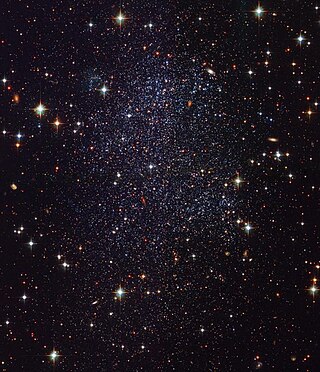Sagittarius Dwarf Irregular Galaxy
Dwarf galaxy in the constellation of Sagittarius From Wikipedia, the free encyclopedia
The Sagittarius Dwarf Irregular Galaxy (SagDIG) is a dwarf galaxy in the constellation of Sagittarius. It lies about 3.4 million light-years away. It was discovered by Cesarsky[who?] et al. on a photographic plate taken for the ESO (B) Atlas on 13 June 1977 using the ESO 1 meter Schmidt telescope.
| SagDIG | |
|---|---|
 SagDIG by Hubble Space Telescope | |
| Observation data (J2000 epoch) | |
| Constellation | Sagittarius |
| Right ascension | 19h 29m 59.0s[1] |
| Declination | −17° 40′ 41″[1] |
| Redshift | −79±1 km/s[1] |
| Distance | 3.39±0.23 Mly (1.04±0.07 Mpc)[2][3] |
| Apparent magnitude (V) | 15.5[1] |
| Characteristics | |
| Type | IB(s)m[1] V (Dwarf irregular galaxy) |
| Apparent size (V) | 2.9′ × 2.1′[1] |
| Other designations | |
| Sagittarius Dwarf Irregular,[1] SGR Dwarf,[1] ESO594-G004,[1] PGC 63287,[1] Kowal's Object[1] | |
The SagDIG is thought to be the member of the Local Group most remote from the Local Group's barycenter. It is only slightly outside the zero-velocity surface of the Local Group.[4]
SagDIG is a much more luminous galaxy than the Aquarius Dwarf and it has been through a prolonged period of star formation.[5] This has resulted in it containing a rich intermediate-age population of stars. Twenty-seven candidate carbon stars have been identified inside SagDIG. Analysis shows that the underlying stellar population of SagDIG is metal-poor (at least [Fe/H] ≤ −1.3). Further, the population is young, with the most likely average age between 4 and 8 billion years for the dominant population.[6]
References
External links
Wikiwand - on
Seamless Wikipedia browsing. On steroids.
